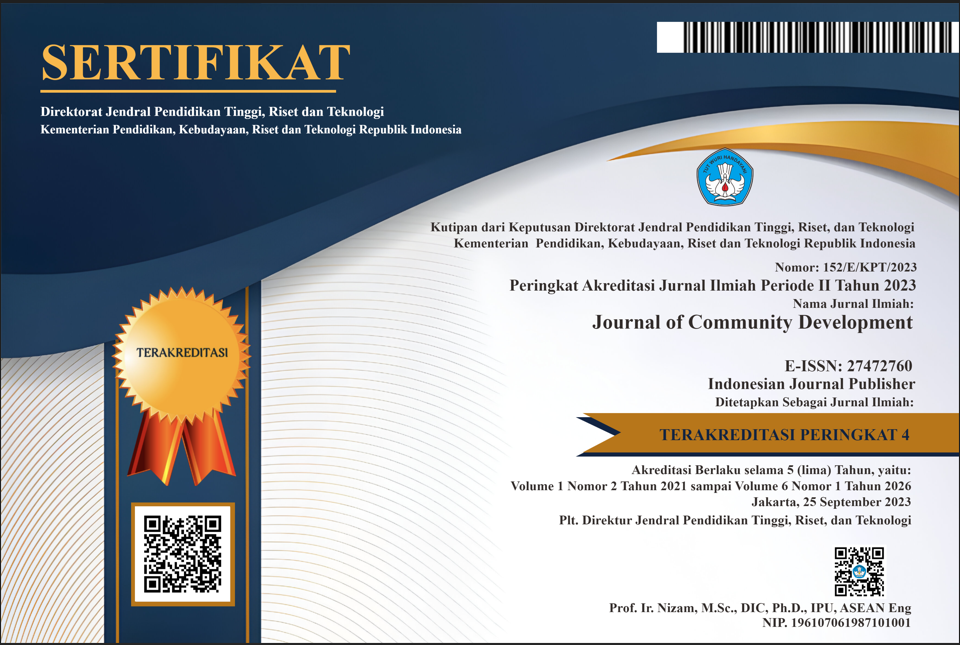Implementasi Sleepiness EWS Pada TRC BPBD Jember Sebagai Usaha Pengurangan Risiko Kecelakaan Kerja
DOI:
https://doi.org/10.47134/comdev.v5i1.236Keywords:
Work Fatigue, Microsleep, Disaster Management, Early Warning SystemAbstract
The Quick Response Team (TRC) of BPBD Jember plays an important role in disaster management. Among their emergency response activities are the mobilization of personnel for victim assistance and the distribution of aid to disaster victims. The nature of TRC's work demands both physical and mental effort. This poses a risk of work fatigue, one manifestation of which is microsleep, which can lead to traffic accidents as experienced by the TRC in 2019. The objective of this community service activity is to implement artificial intelligence that can monitor driver activity to reduce the risk of traffic accidents. The method of this service activity involves the installation of a sleepiness early warning system (EWS) in TRC BPBD Jember vehicles. The device is mounted on the dashboard, facing the driver, and powered by a 12-volt car battery. Based on interviews, the implementation of the sleepiness EWS in the operational vehicles of TRC BPBD Jember has been able to enhance driving safety by providing warnings to drivers when they begin to lose concentration, whether due to fatigue or distractions. Although there were challenges in implementing the device, such as slow response time and limited detection range, the community service team overcame these issues by recalibrating the device's response time and selecting drivers with similar anthropometric measurements to avoid the need for frequent adjustments when changing drivers.
Downloads
References
Ariyanti, S. (2023) Keselamatan Pasien dan Keselamatan Kesehatan Kerja. Jambi: Sonpedia Publishing Indonesia.
CNN (2018) Mobil BPBD Jember masuk parit, CNN. Available at: https://www.youtube.com/watch?v=qGW5rT6hK-4&ab_channel=CNNIndonesia.
Cralle, T., Brown, W. D. and Cane, W. (2016) Sleeping Your Way to the Top How to Get the Sleep You Need to Succeed. New York: Sterling Publishing.
Ramey, S. et al. (2019) ‘Drowsy and dangerous? Fatigue in paramedics: An overview’, Irish Journal of Paramedicine, 4(1).
Sikander, G. and Anwar, S. (2019) ‘Driver Fatigue Detection Systems: A Review’, IEEE Transactions on Intelligent Transportation Systems, 20(6).
Suyoso, G. E. J. et al. (2024) ‘Edukasi Tentang Microsleep Sebagai Upaya Pengurangan Risiko Kecelakaan Kerja pada TRC BPBD Kabupaten Jember’, NaCosVi : Polije Proceedings Series, 6(1), pp. 161–164.
Tunny, I. S. and Malisngorar, M. S. J. (2023) Buku Ajar Dasar-Dasar Keselamatan dan Kesehatan Kerja. NEM.
Wahyunik, S. (2018) Pulang dari Lokasi Longsor, Mobil Bnpb di jember Ini Masuk Sungai, Diduga Sopir Mengantuk, Tribunjatim.com.
Downloads
Published
How to Cite
Issue
Section
License
Copyright (c) 2024 Bakhtiyar Hadi Prakoso, Gandu Eko Julianto Suyoso, Veronika Vestine, Sugeng Hartanto

This work is licensed under a Creative Commons Attribution 4.0 International License.







